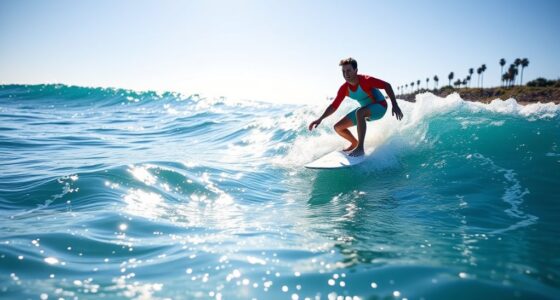To find good surfing waves, start by understanding wave characteristics like swell size and type. Beginners should look for waves under 0.5 meters, while intermediates can handle up to 1 meter. Pay attention to wind conditions; offshore winds create smoother waves, enhancing your ride. Check tide patterns too, as incoming tides often lead to better conditions. Get familiar with local spots by connecting with seasoned surfers in the area. They can offer invaluable insights into the best times and places for peak surf. There's much more to uncover about honing your skills and making the most of your sessions.
Key Takeaways
- Monitor swell size and wave quality to find suitable surfing conditions for your skill level.
- Pay attention to wind direction; offshore winds create smoother, more enjoyable waves.
- Consider local geography and sea floor profiles, as they significantly influence wave characteristics.
- Engage with local surf communities for insights on the best surf spots and conditions.
Understanding Wave Characteristics
When you're surfing, understanding wave characteristics is essential for selecting the right spot and ensuring a safe, enjoyable experience.
Wave quality plays a vital role in how well you can ride those waves. For beginners, aim for waves under 0.5 meters, as they provide a gentler introduction to the sport. Intermediate surfers can handle swell sizes up to 1 meter comfortably but should be cautious about wave power.
Pay attention to swell size and direction, as these factors notably affect how waves break at various surf spots. For instance, spilling waves break softly and are perfect for learners, while hollow waves are better suited for advanced surfers who can maneuver through barrels.
Also, look for clean and smooth surfaces, which enhance rideability and performance. Choppy waves can be challenging and less enjoyable.
Key Weather and Location Factors

Understanding wave characteristics sets the stage for grasping how key weather and location factors influence your surfing experience. To find the best waves, you need to pay attention to several essential elements.
- Swell Size: Larger swells typically create better surfing conditions, so keep an eye on the forecast for swell size, direction, and period.
- Offshore Winds: These winds help maintain smooth wave surfaces, making them ideal for surfing. Onshore winds, on the other hand, can ruin wave quality and create choppy waters.
Geography also plays a significant role. The orientation of the coastline and the local terrain can either amplify or diminish wave conditions.
Steep sea floor profiles tend to produce faster-breaking waves, while gradual profiles are more suitable for beginners.
Wind Effects on Surf Conditions

Wind plays an essential role in shaping surf conditions, directly influencing wave quality and rideability.
You'll find that offshore winds create ideal surfing conditions by smoothing out waves and enhancing their shape. This means better rideability for you, as light offshore winds can even increase wave height.
On the other hand, onshore winds disrupt wave quality, creating choppy surfaces that can make your session frustrating.
It's important to keep an eye on wind speed and direction. Stronger winds can complicate take-offs and wave riding, so aim for lighter conditions. Cross-shore winds can vary, but with local knowledge, you can still find good waves despite their presence.
Timing is vital, too. Early mornings and late evenings typically offer the best surf conditions due to cooler air and lighter winds.
As you scout for surf spots, monitor the wind effects closely, as even slight changes can greatly impact your experience. By understanding how wind influences waves, you'll be better equipped to choose the right time and place for your next surf adventure.
Basics of Surf Forecasting

How can you effectively plan your surf sessions?
Surf forecasting is essential for predicting the best conditions based on wave height, swell direction, and tides. To catch the best waves, you'll want to check several factors in your surf report:
- Wave Height: Larger swells generally mean better surfing conditions.
- Tide Information: Many beach breaks perform better during incoming tides, so be mindful of the tidal cycles.
Understanding how these elements interact will help you decide where the waves go and when to hit the water.
Pay attention to swell direction as it greatly influences how waves break at specific spots. For instance, some locations may favor a particular swell direction for ideal performance.
Learning Through Experience

Engaging in real surf sessions is the best way to learn about wave dynamics and improve your skills on the water. By spending time in the ocean, you'll gradually get familiar with different swell sizes and types, whether it's beach breaks or point breaks. This hands-on experience builds your confidence and adaptability, vital traits for any surfer.
Connecting with local surf communities is equally important. Seasoned surfers can share invaluable insights about where to find good waves and hidden spots that mightn't be on your radar. Plus, understanding surf etiquette is essential; respecting others in the water not only enhances your experience but fosters a friendly surf culture.
Consider taking surf lessons if you want to accelerate your learning. These guided sessions help you recognize suitable wave conditions and refine your technique. Keeping a surf journal can also be beneficial—document your experiences, conditions, and progress to identify patterns in your surfing journey.
Through these methods, you'll deepen your understanding of wave dynamics and develop a unique personal surfing style, making every session an opportunity to learn and grow.
Navigating Crowded Surf Spots

Maneuvering crowded surf spots requires sharp awareness and strategic positioning to maximize your wave count amidst the chaos.
In famous locations like Super Bank or Pipeline, thousands of surfers are vying for limited waves, so you need to stay alert. Adopting a 'hunter vs hunted' mindset can be a game-changer; actively seek waves instead of waiting for them to come to you.
Here are some tips to help you navigate crowded lineups:
- Sit Under the Pack: Position yourself just inside the main group to find sneaky spots that others might overlook.
- Master the 'Pop and Cork' Technique: This will enhance your timing and positioning, allowing for quicker responses to incoming sets.
Strategies for Crowded Lineups

Finding effective strategies for steering through crowded lineups can make the difference between a frustrating session and a successful day of surfing. Embrace the 'Hunter vs Hunted' mindset; actively seek out waves instead of waiting for them to come to you. This approach guarantees you position yourself strategically to catch more waves.
Utilize the 'Sit Under the Pack' technique, which allows you to observe crowd patterns and identify sneaky spots just inside the main group. This way, you enhance your chances of getting more waves without competing directly against experienced surfers.
Master the 'Pop and Cork' technique to improve your timing and positioning, which is essential for success in crowded conditions. Always stay prepared with the 'On the Half Turn' approach, enabling you to pivot quickly as waves approach, maximizing your chances for successful take-offs.
Importance of Surf Etiquette

Respecting surf etiquette is vital for ensuring everyone enjoys their time in the water and helps prevent accidents in crowded lineups. As a beginner surfer, understanding the rules of surfing is essential for your safety and the safety of others. By following proper etiquette, you can create a positive environment in the water.
Here are some key points to remember:
- Drop-In Rule: Always respect the drop-in rule. If someone is already riding the wave, don't paddle in and take their wave.
- Right of Way: Know the right of way. The surfer closest to the peak of the wave has priority, so yield accordingly.
Being aware of local customs and showing respect for experienced surfers can greatly enhance your surfing experience.
Practicing good etiquette, like not paddling around the lineup unnecessarily, contributes to a more enjoyable surf session for everyone involved.
Surfboard Selection and Maintenance

Choosing the right surfboard is essential for enhancing your performance and enjoyment in the water. When selecting a surfboard, you need to know the right size for your height, weight, and skill level. Beginners should consider wider, thicker boards for added stability and buoyancy. It's also important to understand surfboard volume, as higher volume boards provide better flotation, especially for novice surfers.
Here's a quick reference table to help you choose:
| Skill Level | Recommended Size | Volume (Liters) |
|---|---|---|
| Beginner | 8'0" – 9'0" | 60 – 80 |
| Intermediate | 6'0" – 7'6" | 35 – 55 |
| Advanced | 5'6" – 6'4" | 25 – 35 |
Regular maintenance is key too. Clean your board after each use to prevent wax buildup, and promptly repair any dings or cracks. Store your surfboard in a cool, dry place, ideally in a board bag, to protect it from UV damage and physical impacts. Understanding surfboard parts, like the nose and tail, can also help you customize your equipment effectively.
Frequently Asked Questions
How Do I Find a Good Wave for Surf?
To find a good wave, check swell size and direction online, observe local tide cycles, and monitor wind conditions. Engaging with local surfers can also lead you to hidden spots with better waves.
How Do You Check if the Waves Are Good for Surfing?
Windy weather's wavy wonders can be checked by monitoring surf forecasting sites, evaluating buoy data, and analyzing sea floor shapes. You'll find the best conditions by considering tide timings and local wind factors.
How to Spot Waves for Surfing?
To spot waves for surfing, observe swell size and direction, check tide charts, and monitor wind conditions. Familiarize yourself with local geography and wave characteristics to find the best spots suited for your skills.
How to Find the Perfect Wave?
To find the perfect wave, you'll want to assess swell size and direction, monitor tide charts, and consider wind conditions. Understanding local geography helps too, as it shapes the waves you'll ride.
How Can I Apply Surf Spot Hunting Techniques to Find Big Waves for Surfing?
To find the best big wave surfing locations, it’s essential to apply effective surf spot hunting techniques. Look for areas with strong swells, offshore winds, and plenty of open ocean to generate big waves. Research local weather patterns and consult with experienced surfers to pinpoint the perfect spots for big wave surfing.
Conclusion
As you commence your surf spot hunting journey, remember that the ocean's whispers guide you to hidden gems, much like discovering a secret cove in a timeless adventure.
Embrace the dance of the waves, adapt to their moods, and respect fellow surfers in the lineup.
With patience and an open heart, you'll ride the tides of experience, revealing the artistry of surfing while basking in the sun's embrace.
So grab your board and let the ocean's rhythm lead the way!










